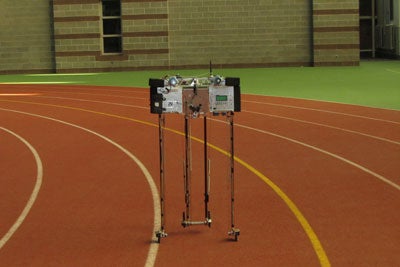Cornell’s Ranger Robot Power-Walks into the Record Books With 14.3-Mile Stroll
Slow and steady really does win the race. A diminutive robot perched atop stork-like legs has slowly strode beyond BigDog’s...

Slow and steady really does win the race. A diminutive robot perched atop stork-like legs has slowly strode beyond BigDog’s world record for robotic walking, making a continuous 11-hour trek around an indoor running track at Cornell University that covered 14.3 miles.
Ranger, developed by Cornell’s Biorobotics and Locomotion Lab, made 108.5 laps around the running track at roughly 700 feet per lap, logging something like 70,000 steps on a single charge. The untethered ‘bot was controlled remotely by human handlers using a simple toy remote control.
For Ranger, the record-breaking performance spelled redemption. Ranger set a record of 5.6 miles in 2008 only to see Boston Dynamics’ somewhat frightening and much larger BigDog more than double the record shortly thereafter, setting the new standard at 12.8 miles.
But it’s also about energy efficiency; while BigDog can climb hills, stay upright on ice, and terrify children, Ranger walks with an efficient gate that emulates human walking, swinging its legs to take advantage of gravity and forward momentum. An understanding of the biomechanical tricks that allow robots to increase their efficiency should lead not only to breakthroughs in robotic design, but also in human prosthetics and rehabilitation.
The video below is a bit old, but it does show off the smooth gait that is the key to Ranger’s walking prowess.
Sustained, self-contained locomotion is a major component in developing an all-in-one humanoid robot. You can read more on the sole American effort to do just that in our August issue cover story here.